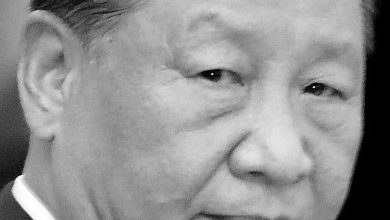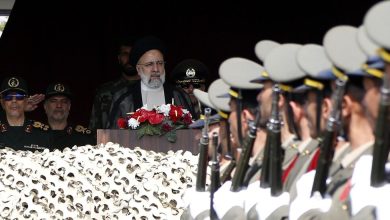Michael Bishop, Genre-Busting Writer Known for Science Fiction, Dies at 78

Michael Bishop, an author who was best known for his award-winning science fiction but who ranged far beyond the genre, venturing into realism, noir mystery and even Southern Gothic, died on Nov. 13 in LaGrange, Ga. He was 78.
His daughter, Stephanie Bishop, said the death, at a hospice facility, was from complications of cancer treatment.
Mr. Bishop emerged in the 1970s as part of a new cohort of science fiction writers, like Ursula K. LeGuin and J.G. Ballard, who were intent on bringing their field into mainstream acceptance.
They sought to present “mature science fiction,” which used imagined worlds and realities to mine fundamental questions of human nature. Mr. Bishop and others saw it as an advancement over their pulpy predecessors and as an antidote to the takeover of their field by mass pop culture, especially after the release of the movie “Star Wars” in 1977.
“Rightly or wrongly, I wanted to reclaim” science fiction, he said in a 2000 interview with the website Infinity Plus, “at least in some of its literary manifestations, as a legitimate medium in which to examine age-old human concerns.”
His first novel, “A Funeral for the Eyes of Fire” (1975, rewritten in 1980 as “The Eyes of Fire”), involves two human brothers who escape a totalitarian Earth only to find themselves enmeshed in the cultural tensions and political intrigues of a distant planet.
Unlike earlier science fiction that treated aliens as two-dimensional and often subhuman, Mr. Bishop presents the alien society of his novel as a world as rich in myth and ritual as anything found on Earth, an approach that won him praise as an “anthropological” writer.
His work often touched on faith — he was an avowed Christian — and race. In one novel, the Nebula Award-winning “No Enemy but Time” (1982), a Black protagonist travels two million years into the past to study pre-human hominids.
Critics widely praised his work, though more than one said that his writing style came across as overly florid at times.
Gerald Jonas, writing in The Times in 1997, called Mr. Bishop “one of science fiction’s more ambitious prose stylists,” but also dinged one of his stories as “a quasi-profound, quasi-comic take on reality that calls to mind the most mannered fables of J.G. Ballard and Philip K. Dick.”
As his career progressed, Mr. Bishop found himself drifting away from science fiction. His last true science-fiction novel, “Brittle Innings” (1994), is a Gothic-tinged tale in which Frankenstein’s monster is alive (more or less) and well, playing minor-league baseball in the small-town South.
His later work ranged broadly. He cowrote two noir mystery novels with Paul Di Filippo, both under a single pseudonym, Philip Lawson: “Would It Kill You to Smile?” (1998) and “Muskrat Courage” (2000). In 2019, he published a collection of almost entirely nonscience-fiction, “Other Arms Reach Out to Me: Georgia Stories” (2019).
“I write SF, when I choose to do so, because it seems the best medium in which to say whatever I want to say at that moment,” he wrote on his website. “And, sometimes, when I don’t write SF, I don’t write it not only because other images and vocabularies have seized my imagination, but also because the stigma that still attaches to such work.”
Michael Lawson Bishop was born on Nov. 12, 1945, in Lincoln, Neb., where his father, Leotis Bishop, was stationed with the U.S. Army Air Force. His mother, Maxine (Matison) Bishop, later worked in the personnel department at McConnell Air Force Base near Wichita, Kan.
His father’s military career kept the family moving around when Michael was young, and after his parents divorced in 1951, he split his time between them — a peripatetic experience, he later said, which fueled his interest in imaginative fiction.
He studied English at the University of Georgia, graduating in 1967 and receiving a master’s degree in the same subject a year later. He taught English at the U.S. Air Force Academy Preparatory School, then at the University of Georgia in Athens.
He began writing short stories in the late 1960s, and at first shied away from science fiction.
“When I started writing, I submitted to literary markets that returned my stories with preprinted rejections,” he wrote on his website. “A friend advised me to try the SF markets, my fifth submission sold, and, voilà, I was a science-fiction writer.”
His first story, “Piñon Fall,” appeared in 1970 in Galaxy Science Fiction magazine, and within a few years his work had appeared in most of the major sci-fi publications. He left teaching in 1974 to write full time, though he returned to the classroom between 1996 and 2012, when he taught at LaGrange College in Georgia.
He married Jeri Whitaker in 1969. Along with their daughter, his wife survives him, as do two grandchildren; his stepbrother, Robert Willis; and his stepsister, Barbara Reese.
Mr. Bishop’s son, Jamie, a graphic artist, illustrated the covers for several of his books. In 2007, while teaching at Virginia Tech, Jamie was among the 32 people killed by a gunman on campus.
Mr. Bishop and his wife became advocates for gun control, at one point traveling to the Georgia State Capitol to testify against a bill that would make it easier to carry concealed weapons in public.
The law passed, but Mr. Bishop found other ways to rail against gun culture. In 2015, he published “Of Rattlesnakes and Men” in the magazine Asimov’s Science Fiction.
The story posits a world in which gunpowder was never invented, but scientists have figured out a way to bioengineer venomous snakes to act as weapons. The story focuses on a fictional town in Georgia that mandates that all residents carry a snake in public, for self-defense.
“It’s no more over the top than the positions our legislators take on this issue, in the way that they want to put guns in every possible venue — whether it’s bars or churches or schools,” Mr. Bishop told The Atlanta Journal-Constitution in 2015. “Everywhere.”
The story is obvious satire, only barely concealing the rage he felt over his son’s murder — and rage, he said, was a thread running through all his work.
“The human condition, along with ignorance and/or greed, continually triggers brutality,” he told Infinity Plus. “I have no shortage of outrage, and outrage often fuels my fiction.”



